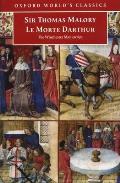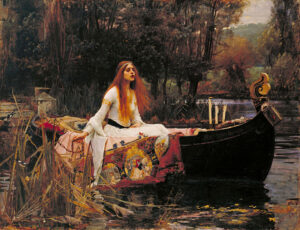
Holy Grail Tapestry: The Failure of Sir Lancelot by Sir Edward Burne-Jones, overall design and figures; William Morris, overall design and execution; John Henry Dearle, flowers and decorative details.
I’m still trucking through Malory’s Morte Darthur after a short break last week to read some Old English elegies and William Morris’s Arthurian poems. Malory’s brutal optimism started to wear on me and I found darker poems strangely consoling. But today I’m back and finishing up the grail quest cycle.
Since it’s Trinity Sunday, I thought we would look at Lancelot’s vision of the Trinity at the end of his quest for the grail:
Then looked he [Lancelot] up into the midst of the chamber, and saw a table of silver, and the holy vessel covered with red samite, and many angels about it, wherof one held a candle of wax burning, and the other held a cross and the ornaments of an altar. And before the holy vessel he saw a good man clothed as a priest; and it seemed to Sir Lancelot that above the priest’s hands were three men, wherof the two put the youngest by likeness between the priest’s hands; and so he lifted them up right high, and it seemed to show so to the people. And then Sir Lancelot marvelled not a little, for him thought the priest was so greatly charged of the figure that him seemed that he should fall to the earth.
Here’s Helen Cooper’s notes on this little theophany:
What is being described here is the priest’s elevation of the Host to show the congregation at the Mass, only with its theological meaning rendered visible: the figure placed between the priest’s hands is Christ Himself, Who is embodied in the Mass wafer. The two figures who place the third between the priest’s hands are the Father and the Holy Ghost.
There’s some resonance here with the legend of the Mass of St. Gregory. Here’s one example of the image from a little bit after Malory wrote, but there are many more.

Mass of St. Gregory from 1498 Sarum Missal
As recorded in The Golden Legend, the Mass of St. Gregory recounts a Eucharistic miracle performed by Pope Gregory. According to the legend, Gregory hears a widow scoff at the possibility of transubstantiation while he prays the liturgy. The widow contends that she knows transubstantiation cannot be possible since she baked the bread herself. In response, Gregory prays for and receives a sign in which the host visibly transforms into flesh:
It happed that a widow that was wont every Sunday to bring hosts to sing mass with, should on a time be houseled and communed, and when S. Gregory should give to her the holy sacrament in saying: Corpus domini nostri, etc., that is to say: The body of our Lord Jesu Christ keep thee into everlasting life, anon this woman began to smile tofore S. Gregory, and anon he withdrew his hand, and remised the sacrament upon the altar. And he demanded her, tofore the people, why she smiled, and she said: Because that the bread that I have made with my proper hands thou namest it the body of our Lord Jesu Christ. Anon S. Gregory put himself to prayer with the people, for to pray to God that hereupon he would show his grace for to confirm our belief, and when they were risen from prayer, S. Gregory saw the holy sacrament in figure of a piece of flesh as great as the little finger of an hand, and anon after, by the prayers of S. Gregory, the flesh of the sacrament turned into semblance of bread as it had been tofore, and therewith he communed and houseled the woman, which after was more religious, and the people more firm in the faith.
Though the Gregory image is Christocentric and Malory’s description is focused on Trinitarian theology, the visual resonance between the two is fascinating. This is a stage in Lancelot’s life where he too is more religious, though that won’t last long as we move toward the fall of Camelot.
Stay tuned. Tomorrow we’re going to look at monasticism in Malory.
Today’s Arthurian quotes are from Helen Cooper’s edition of Thomas Malory’s Le Morte Darthur from the Winchester Manuscript.





One response
[…] Lancelot’s Vision of the Trinity […]